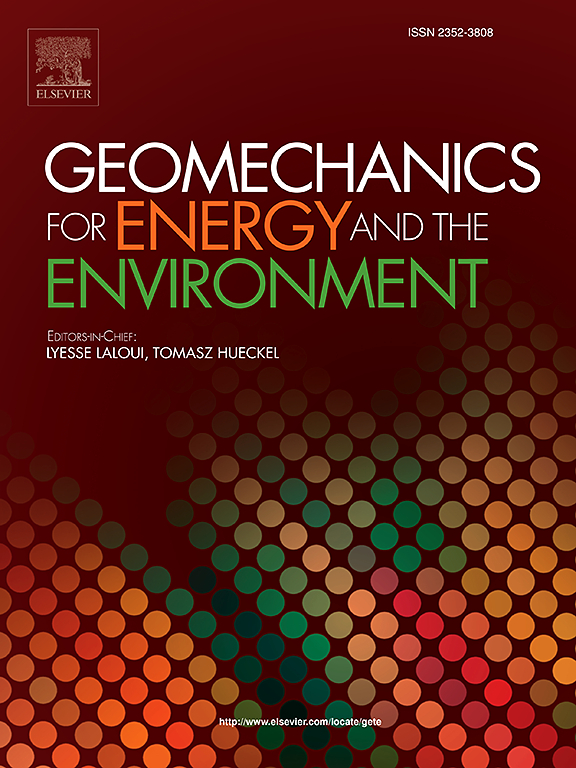水流方向和土壤特性对渗透敏感性的影响:分析土壤阻力和过滤效应
IF 3.3
2区 工程技术
Q3 ENERGY & FUELS
引用次数: 0
摘要
文献中描述的大多数渗透试验是通过对均匀试样施加垂直流动来进行的,而在现场,流动可以在另一个方向上,土壤可能显示密度和粒度分布的局部变化。采用多向流动装置,在垂直或水平流动条件下进行一系列的渗透试验。对两种粒径分布和密度稍有不同的无粘性土进行了试验研究。样品要么由单一土壤组成,要么由双层土壤组成,即每种土壤都有一层。渗透敏感性由两个临界水力梯度和一个抗侵蚀指数表征。在目前的测试方法下,局部密度变化对渗透敏感性的影响并不显著。结果表明:水平水流作用下,各试验土均质性增强,但抗渗透能力略有增强;当考虑双层试样和平行于土界面的水流时,渗透敏感性主要由最易侵蚀的土壤控制。另一方面,当水流垂直于土界面时,渗透敏感性主要由最抗土控制。结果还强调了孔径对过滤的影响,并对下游过滤器孔径的选择进行了讨论。本文章由计算机程序翻译,如有差异,请以英文原文为准。
Impact of flow direction and soil characteristics on suffusion susceptibility: Analyzing soil resistance and filtration effects
Most suffusion tests described in the literature are performed by applying a vertical flow to homogenous specimens, whereas on site, the flow can be in another direction and the soil may display local variations of density and grain size distribution. A series of suffusion tests are performed with a multi-direction flow device, under vertical or horizontal flow. Two cohesionless soils which slightly differ by their grain size distribution and density are tested. Specimens are either composed of a single soil or bi-layered, i.e. a layer of each soil. The suffusion susceptibility is characterized by two critical hydraulic gradients and an erosion resistance index. With the current testing procedure, the influence of the local density variations on the suffusion susceptibility is not significant. The results show that under horizontal flow, each tested soil becomes more heterogeneous, but also slightly more resistant towards suffusion. When considering bi-layered specimens and a flow parallel to the soil interface, the suffusion susceptibility is mainly controlled by the most erodible soil. On the other hand, when the flow is perpendicular to the soil interface, the suffusion susceptibility is mainly controlled by the most resistant soil. The results also highlight the influence of pore opening on the filtration and the selection of the pore opening of the downstream filter is discussed.
求助全文
通过发布文献求助,成功后即可免费获取论文全文。
去求助
来源期刊

Geomechanics for Energy and the Environment
Earth and Planetary Sciences-Geotechnical Engineering and Engineering Geology
CiteScore
5.90
自引率
11.80%
发文量
87
期刊介绍:
The aim of the Journal is to publish research results of the highest quality and of lasting importance on the subject of geomechanics, with the focus on applications to geological energy production and storage, and the interaction of soils and rocks with the natural and engineered environment. Special attention is given to concepts and developments of new energy geotechnologies that comprise intrinsic mechanisms protecting the environment against a potential engineering induced damage, hence warranting sustainable usage of energy resources.
The scope of the journal is broad, including fundamental concepts in geomechanics and mechanics of porous media, the experiments and analysis of novel phenomena and applications. Of special interest are issues resulting from coupling of particular physics, chemistry and biology of external forcings, as well as of pore fluid/gas and minerals to the solid mechanics of the medium skeleton and pore fluid mechanics. The multi-scale and inter-scale interactions between the phenomena and the behavior representations are also of particular interest. Contributions to general theoretical approach to these issues, but of potential reference to geomechanics in its context of energy and the environment are also most welcome.
 求助内容:
求助内容: 应助结果提醒方式:
应助结果提醒方式:


